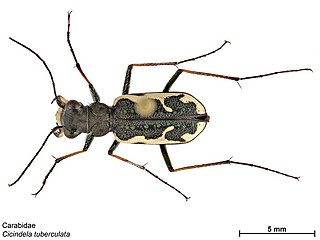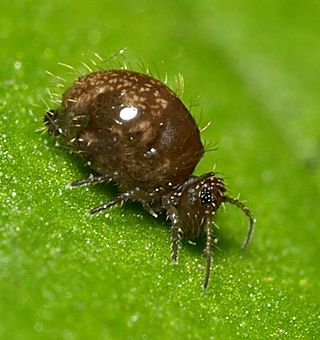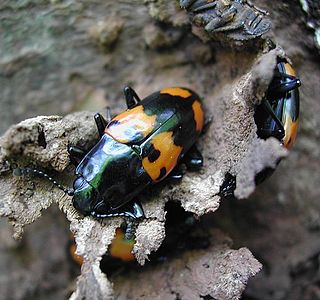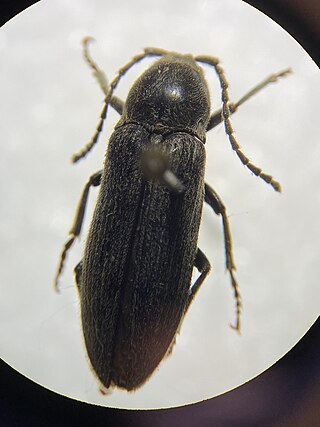
Silphidae is a family of beetles that are known commonly as large carrion beetles, carrion beetles or burying beetles. There are two subfamilies: Silphinae and Nicrophorinae. Members of Nicrophorinae are sometimes known as burying beetles or sexton beetles. The number of species is relatively small, at around two hundred. They are more diverse in the temperate region although a few tropical endemics are known. Both subfamilies feed on decaying organic matter such as dead animals. The subfamilies differ in which uses parental care and which types of carcasses they prefer. Silphidae are considered to be of importance to forensic entomologists because when they are found on a decaying body they are used to help estimate a post-mortem interval.

Weevils are beetles belonging to the superfamily Curculionoidea, known for their elongated snouts. They are usually small – less than 6 mm in length – and herbivorous. Approximately 97,000 species of weevils are known. They belong to several families, with most of them in the family Curculionidae. It also includes bark beetles, which while morphologically dissimilar to other weevils in lacking the distinctive snout, is a subfamily of Curculionidae. Some other beetles, although not closely related, bear the name "weevil", such as the biscuit weevil, which belongs to the family Ptinidae.

The Cupedidae are a small family of beetles, notable for the square pattern of "windows" on their elytra, which give the family their common name of reticulated beetles.

The insects of the beetle family Chrysomelidae are commonly known as leaf beetles, and include over 37,000 species in more than 2,500 genera, making up one of the largest and most commonly encountered of all beetle families. Numerous subfamilies are recognized, but the precise taxonomy and systematics are likely to change with ongoing research.

The Agromyzidae are a family of flies, commonly referred to as the leaf-miner flies for the feeding habits of their larvae, most of which are leaf miners on various plants. It includes roughly 2,500 species, they are small, some with wing length of 1 mm. The maximum size is 6.5 mm. Most species are in the range of 2 to 3 mm.

Neocicindela tuberculata is a species of tiger beetle in the family Cicindelidae, endemic to New Zealand. Its common names include common tiger beetle, moeone, and papapa, and in its larval stage penny doctor, butcher boy, kapuku, kui, kurikuri, moeone, and muremure. Neocicindela tuberculata was the first carabid beetle described from New Zealand. The species can run as fast as 5 miles per hour and are considered to be the fastest running beetles. Adult species prefer clay banks in summer and are good predators when in comes to insects.

Melolonthinae is a subfamily of the scarab beetles. It is a very diverse group; distributed over most of the world, it contains over 11,000 species in over 750 genera. Some authors include the scarab subfamilies Euchirinae and Pachypodinae as tribes in the Melolonthinae.

Lytta magister, the desert blister beetle or master blister beetle, is a species of blister beetle found in southwestern North America.

Chironomus is a genus of nonbiting midges in the subfamily Chironominae of the bloodworm family, Chironomidae, containing several cryptic species that can only be distinguished by experts based on the characteristics of their giant chromosomes.

Allacma fusca is a species of springtail. This species is endemic to western areas of Continental Europe and the British Isles, where it lives in the surface layers of the soil in moist habitats such as among leaf litter.

Megalodacne is a genus of fungivorous beetles in the family Erotylidae.

Pyropterus nigroruber is a species of net-winged beetles belonging to the family Lycidae.

Polycaon stoutii, the black polycaon or Stout's branch borer, is a species of woodboring beetle in the Bostrichidae family. It is found in North America in British Columbia, the Pacific Coast states, and Arizona, but has spread elsewhere due to the shipping of wood products.
Phyllotreta liebecki is a species of flea beetle in the family Chrysomelidae. It is found in North America.

Pacificanthia consors, also known as the brown leatherwing beetle, is a species of soldier beetle in the family Cantharidae. It is found in North America, mainly in California. Adults are 14-19 mm in length. They are orange with brown wing covers, and the legs are reddish with black markings. Adults are mostly commonly on the wing in April and May. Adult beetles and their larva both spend most of their time in plant litter where they prey on other soil fauna.

Luperus viridipennis is a species of skeletonizing leaf beetle belonging to the family Chrysomelidae, subfamily Galerucinae.

Lepidiota is a genus of beetles belonging to the family Scarabaeidae.

Hypoborus ficus, the fig bark beetle, is a species of weevil found in many European, Mediterranean and Asian countries.

Perothops is a genus of false click beetles in the family Eucnemidae containing 3 species. They are known as beech-tree beetles or perothopid beetles. They are small as they are only 10–18 millimeters long. It is the only genus in the monotypic subfamily Perothopinae. They are dark-colored beetles that are found across the United States, generally in forests. The genus was discovered by Johann Friedrich von Eschscholtz in 1836. It used to be considered a family not part of Eucnemidae. The genus's name is from Greek, translating to "maimed/crippled eye" or "eye of little necklaces/bands", referring to the placement of perothopid eyes.
Anthrenus (Florilinus) kompantzevi is a little known species of carpet beetle in the family Dermestidae native to Kyrgyzstan. Species have been noted from southwest part of Kyrgyzstan to the Kyrgyz Ala-Too mountain range near canyons of Kara Balta river.


















